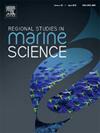Tidal currents and atmospheric inorganic nitrogen contribute to diurnal variation of dissolved nutrients and chlorophyll a concentrations in Mirs Bay, Hong Kong
IF 2.1
4区 环境科学与生态学
Q3 ECOLOGY
引用次数: 0
Abstract
The surface layer of central Mirs Bay exhibits high chlorophyll a concentrations despite having lower dissolved nitrate levels than other parts of Hong Kong. It is hypothesised that tidal currents and atmospheric inorganic nitrogen bring in nutrients that could be rapidly consumed by primary producers. We conducted fieldwork campaigns in September and December 2022 to test these hypotheses. Surface seawater was obtained hourly in September and half-hourly in December, and concentrations of chlorophyll a and dissolved nutrients were determined. Nitrogen content of aerosols was measured by a newly-developed online analyser. In September, we observed peaks in dissolved nutrients and chlorophyll a after receding tides, which may have transported nutrients from the surrounding land. In December, there were anomalous nutrient and chlorophyll peaks that could not be attributed to low tides. These peaks may be responses to the overnight deposition of atmospheric nitrogen. Our dataset thus supports our hypotheses and highlights the need for further investigation to quantify the impact of both tidal currents and atmospheric deposition on carbon export to and oxygen consumption in bottom waters. The rapid changes observed could also be due to tidal currents transporting nutrients and chlorophyll a simultaneously. Follow-up studies can repeat the fieldwork using Lagrangian (i.e. following tidal currents) instead of Eulerian (i.e. static sampling points) sampling. Moreover, current results indicate strong diurnal variability in chlorophyll a and suggest that existing monitoring efforts may be biased, depending on their timing during the day and/or the season.
求助全文
约1分钟内获得全文
求助全文
来源期刊

Regional Studies in Marine Science
Agricultural and Biological Sciences-Ecology, Evolution, Behavior and Systematics
CiteScore
3.90
自引率
4.80%
发文量
336
审稿时长
69 days
期刊介绍:
REGIONAL STUDIES IN MARINE SCIENCE will publish scientifically sound papers on regional aspects of maritime and marine resources in estuaries, coastal zones, continental shelf, the seas and oceans.
 求助内容:
求助内容: 应助结果提醒方式:
应助结果提醒方式:


